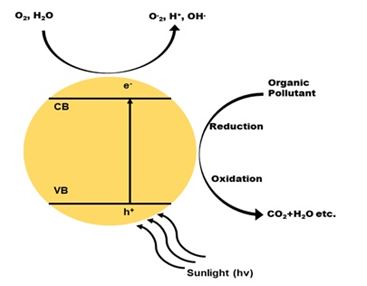From UPSC perspective, the following things are important :
Prelims level: NiTF Nanocomposite; Nanotechnology.
Why in the News?
A new metal oxide nanocomposite has been developed by The Institute of Advanced Study in Science and Technology (IASST) that can help photocatalytic degradation of organic pollutants like dyes and pharmaceuticals and hence can be used as sustainable technologies for cleaning up the environment.
Understanding Photocatalysis and Metal Oxides
- Photocatalysis is a process that uses light to accelerate chemical reactions, particularly useful for degrading harmful substances in water and air.
- They facilitate this reaction without being consumed.
- Examples: Titanium Dioxide (TiO2), Zinc Oxide (ZnO) and Tungsten Trioxide (WO3)

How do they work?
- When exposed to light, these metal oxides generate electron-hole pairs.
- These pairs are highly reactive and can break down pollutants into harmless by-products.
- Work Efficiency: The overall efficiency of this process depends on several factors, including the choice of metal oxide, its crystal structure, light intensity, pollutant concentration, pH level, and the amount of catalyst used.
- Optimisation: Optimizing these factors is crucial for maximising the degradation rates of pollutants. Adjustments in the type of metal oxide, light parameters, and other conditions can significantly enhance the photocatalytic efficiency.
Breakthrough by IASST: NiTF Composite
- The team developed a nanocomposite called NiTF, which stands for Nickel-doped Titanium Dioxide on Fuller’s Earth.
- This innovative material combines the photocatalytic properties of titanium dioxide with the adsorption capabilities of Fuller’s earth, a type of natural clay.
What is Fuller Earth?
|
Testing and Results
- The NiTF nanocomposite was tested for its ability to decolorize methylene blue, a common dye.
- Methylene blue is a persistent pollutant toxic to aquatic life, harmful to human health, and causes colour pollution in water bodies.
- The results were impressive, with the composite achieving a 96.15% decolorization of the dye solution at a pH of 9.0 under visible light within 90 minutes.
- Fuller’s earth enhanced the TiO2’s ability to adsorb pollutants, even in the absence of light.
- This suggests that the NiTF nanocomposite could be a cost-effective solution for environmental photocatalysis, providing benefits even in low-light conditions.
Potential Applications
- Catalysis: The nanocomposite can enhance the efficiency of various chemical reactions.
- Energy Storage: It has the potential to improve systems for storing energy.
- Sensors: The material can be used to develop highly sensitive detection devices.
- Optoelectronics: The nanocomposite can advance technologies that use light for electronic devices.
- Biomedical Fields: It can be applied in medical treatments and diagnostics.
- Coatings: The material can be used to create protective and functional surfaces.
- Renewable Energy: It can facilitate water splitting to produce renewable energy.
PYQ:[2015] With reference to the use of nanotechnology in the health sector, which of the following statements is/are correct?
Select the correct answer using the code given below: (a) 1 only |
Get an IAS/IPS ranker as your 1: 1 personal mentor for UPSC 2024

